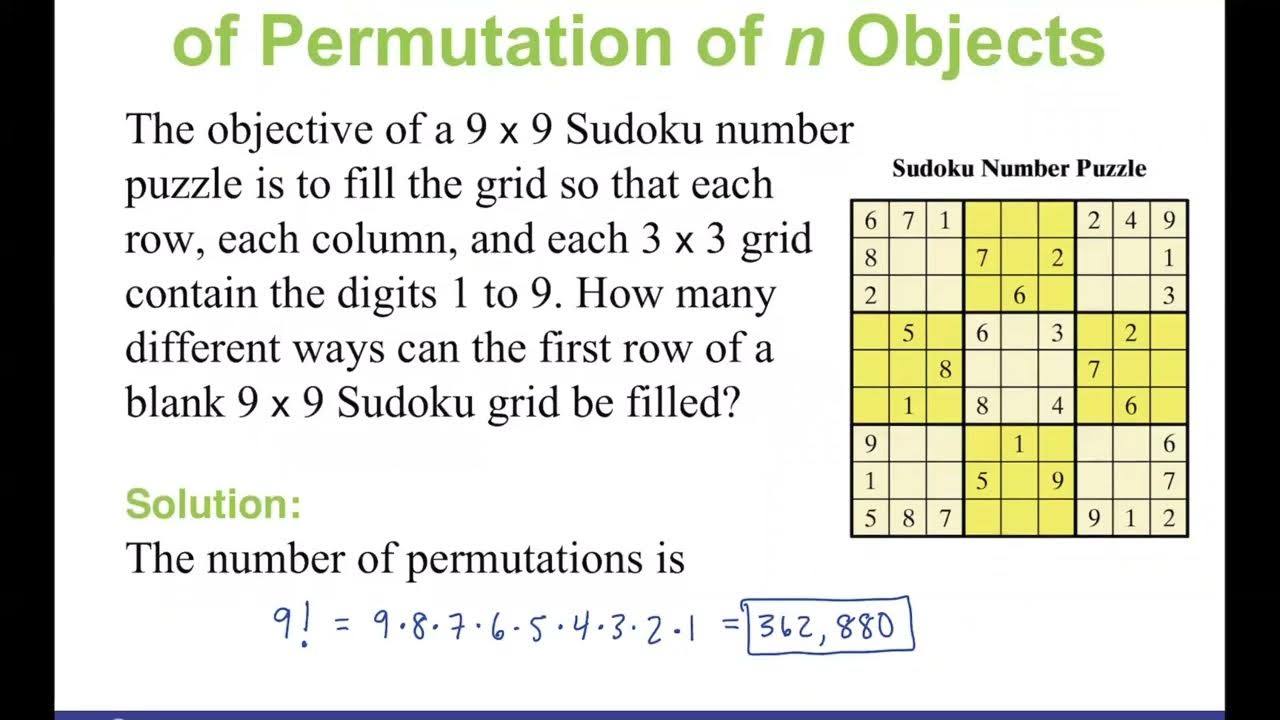Kaidah Pencacahan 3 - Permutasi dan Kombinasi Matematika Wajib Kelas 12
Summary
TLDRIn this video, Deni explains key concepts in counting principles, focusing on permutations and combinations. After reviewing factorials, which involve multiplying integers down to one, Deni illustrates how to simplify complex factorial expressions. The video then moves on to permutations, emphasizing the importance of order in certain cases, and provides practical examples like selecting a committee. Finally, the concept of combinations is introduced, showing how order doesn't matter in other scenarios, such as handshakes. The video concludes with a set of practice problems to reinforce understanding of these mathematical concepts.
Takeaways
- 😀 Introduction to the topic of counting principles, focusing on permutations and combinations.
- 😀 Understanding factorials, including how to calculate n! (n factorial) and its application in solving mathematical problems.
- 😀 Explanation of how to simplify factorial expressions, with an example of 10! divided by 8!.
- 😀 Clear explanation that zero factorial (0!) is always equal to 1.
- 😀 Example of calculating 11! divided by 10! + 9! using simplification techniques.
- 😀 Introduction to permutations as arrangements where the order matters (e.g., AB is different from BA).
- 😀 Formula for calculating permutations: P(n, r) = n! / (n-r)!
- 😀 Example of calculating permutations for selecting a president, secretary, and treasurer from 7 candidates, resulting in 210 possible arrangements.
- 😀 Introduction to combinations, which are selections where the order does not matter (e.g., AB is the same as BA).
- 😀 Formula for calculating combinations: C(n, r) = n! / [(n-r)! * r!]
- 😀 Example of calculating the number of possible handshakes at a meeting with 10 people, which results in 45 possible handshakes.
Q & A
What is a factorial and how is it calculated?
-A factorial of a positive integer n, denoted as n!, is the product of all positive integers from n down to 1. For example, 3! = 3 × 2 × 1 = 6, and 5! = 5 × 4 × 3 × 2 × 1 = 120.
What is the value of 0!?
-The value of 0! is defined as 1, which is a special rule in factorial mathematics.
How can you simplify expressions involving factorials like 10! ÷ 8!?
-When simplifying expressions such as 10! ÷ 8!, you can cancel out the common 8! from the numerator and denominator, leaving you with 10 × 9 = 90.
What is the difference between permutations and combinations?
-Permutations consider the order of elements, while combinations do not. For example, in permutations, the order of selection matters (AB is different from BA), but in combinations, AB is the same as BA.
How do you calculate the number of possible permutations of 7 people where 3 positions are to be filled?
-The number of permutations of 7 people taken 3 at a time can be calculated using the formula P(n, r) = n! / (n - r)!, which in this case is 7! / (7 - 3)! = 7 × 6 × 5 = 210.
What does the formula for permutations look like?
-The formula for permutations is P(n, r) = n! / (n - r)!, where n is the total number of elements and r is the number of elements to be selected or arranged.
What is the formula for combinations?
-The formula for combinations is C(n, r) = n! / ((n - r)! * r!), where n is the total number of elements and r is the number of elements to be selected without regard to order.
How do you calculate the number of handshakes in a room with 10 people, where everyone shakes hands with each other exactly once?
-The number of handshakes in a room with 10 people can be calculated using combinations, as the order of the handshakes doesn't matter. The number of ways to choose 2 people from 10 is C(10, 2) = 10! / (8! * 2!) = 45.
How many different ways can a student choose 6 questions from 8 available questions if 2 specific questions are mandatory?
-The student has to choose 6 questions from the remaining 8 questions after including the mandatory ones. The number of ways to do this is calculated using combinations, C(8, 6) = 8! / (2! * 6!) = 28.
What does a permutation with repeated elements, like in the case of identical objects, look like?
-A permutation with repeated elements is calculated by dividing the factorial of the total number of elements by the factorial of the number of repeated elements. For example, if there are 3 identical objects in a set of 5, the formula would be 5! / 3!.
Outlines

Этот раздел доступен только подписчикам платных тарифов. Пожалуйста, перейдите на платный тариф для доступа.
Перейти на платный тарифMindmap

Этот раздел доступен только подписчикам платных тарифов. Пожалуйста, перейдите на платный тариф для доступа.
Перейти на платный тарифKeywords

Этот раздел доступен только подписчикам платных тарифов. Пожалуйста, перейдите на платный тариф для доступа.
Перейти на платный тарифHighlights

Этот раздел доступен только подписчикам платных тарифов. Пожалуйста, перейдите на платный тариф для доступа.
Перейти на платный тарифTranscripts

Этот раздел доступен только подписчикам платных тарифов. Пожалуйста, перейдите на платный тариф для доступа.
Перейти на платный тарифПосмотреть больше похожих видео

Kaidah Pencacahan, aturan penjumlahan, aturan perkalian, filling slot mudah dan gampang dipahami.

How to do Questions of fundamental principle of counting|permutations combinations|BBA Maths|BCAMath

Kaidah Pencacahan • Part 7: Permutasi

Math 119, 4.4 Lecture Video

Math 123 - Elementary Statistics - Lecture 12

Materi Aturan Pencacahan (Peluang bagian 1)
5.0 / 5 (0 votes)
